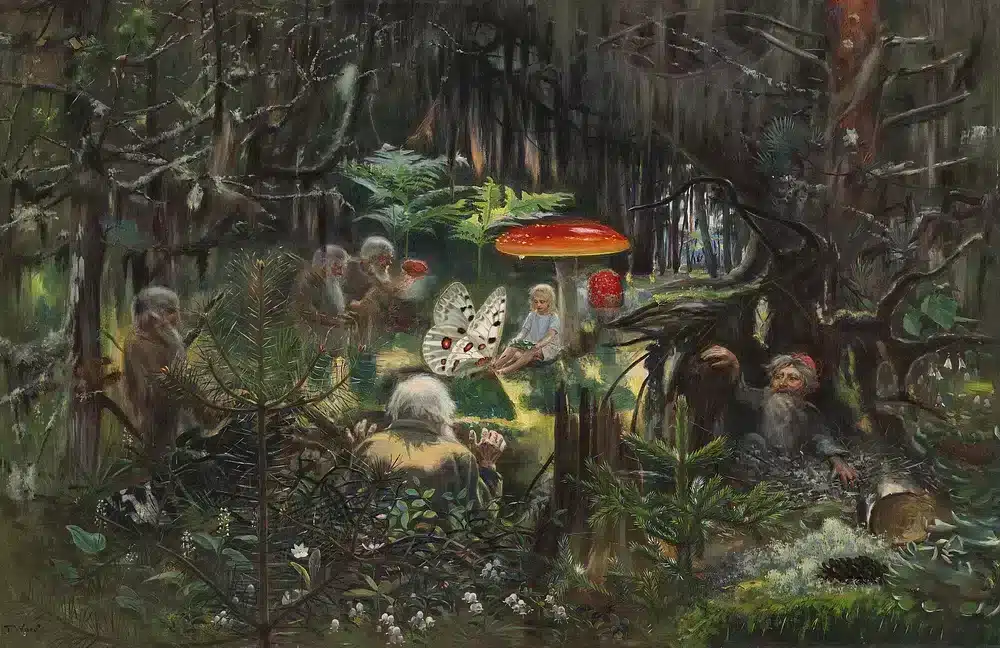
In a humble cottage near a vast forest, a poor woodcutter and his wife lived with their three-year-old daughter. They were so destitute they could barely afford food. One day, the woodcutter encountered a radiant woman with a crown of stars who introduced herself as the Virgin Mary. She offered to take care of his daughter, and the woodcutter agreed, entrusting his child to her care.
In heaven, the girl enjoyed a blissful life with the little angels. When she turned fourteen, the Virgin Mary entrusted her with the keys to heaven’s thirteen doors while she went on a journey. The girl could open twelve doors, but the thirteenth was forbidden. Her curiosity piqued, she disobeyed and opened the thirteenth door, glimpsing the divine Trinity. A golden touch on her finger from the heavenly light marked her disobedience.
Upon the Virgin Mary’s return, the girl denied opening the door thrice. Disappointed, the Virgin Mary banished her to a desolate wilderness. Mute and alone, she survived on roots and berries, living in an old hollow tree. Seasons passed, and her clothes turned to tatters, with her long golden hair as her only covering.
One day, the King discovered the enchanting girl in the woods and took her to his castle. Despite her muteness, her beauty captivated him, and they married. In time, she bore a son, but the Virgin Mary took him away, promising to return him and restore her speech if she admitted her transgression. The girl refused, and the people accused her of devouring her child.
The following year, the same scenario unfolded with her second child. Again, she refused to confess, and her child vanished. The third year, after giving birth to a daughter, the Virgin Mary led the girl to heaven, showing her three children. Despite this, the girl remained stubborn, and her third child was taken.
Soon after, she was put on trial, accused of cannibalism, and sentenced to burn at the stake. As the flames licked at her, remorse filled her heart. She admitted her sin, and the Virgin Mary, moved by her repentance, intervened. The flames were extinguished, and her children were returned to her. The Virgin Mary restored her speech and blessed her with happiness for the rest of her life, teaching that forgiveness is granted to those who sincerely repent and acknowledge their wrongdoings.
What principles and lessons can be learned from the above stories?
The story teaches several principles and lessons that can be applied to our lives:
1. Obedience and trust: Following the guidance and instructions of someone wiser or more experienced is important. Disobeying their advice may lead to consequences, as seen when the girl disobeys the Virgin Mary.
2. Curiosity and self-control: While curiosity is natural, it’s essential to exercise self-control and respect boundaries. The girl’s overwhelming curiosity leads her to open the forbidden door, resulting in her downfall.
3. Honesty and humility: Admitting our mistakes and being truthful, even when it’s difficult, is crucial. The girl’s refusal to admit her wrongdoing causes her suffering, and only when she humbles herself and confesses does she find redemption.
4. The power of repentance and forgiveness: Recognizing our errors and genuinely repenting can lead to redemption and forgiveness. The Virgin Mary forgives the girl once she sincerely repents, showing the power of mercy and second chances.
5. The importance of family and love: Throughout the story, the love and bond between family members play a significant role. The king’s love for his wife, and the girl’s love for her children, are central to the narrative, highlighting the value of love and support in overcoming hardships.
6. Resilience and personal growth: The girl endures suffering and hardship, but ultimately emerges as a better person who has learned valuable life lessons. This demonstrates the importance of resilience and personal growth, even in difficult circumstances.


